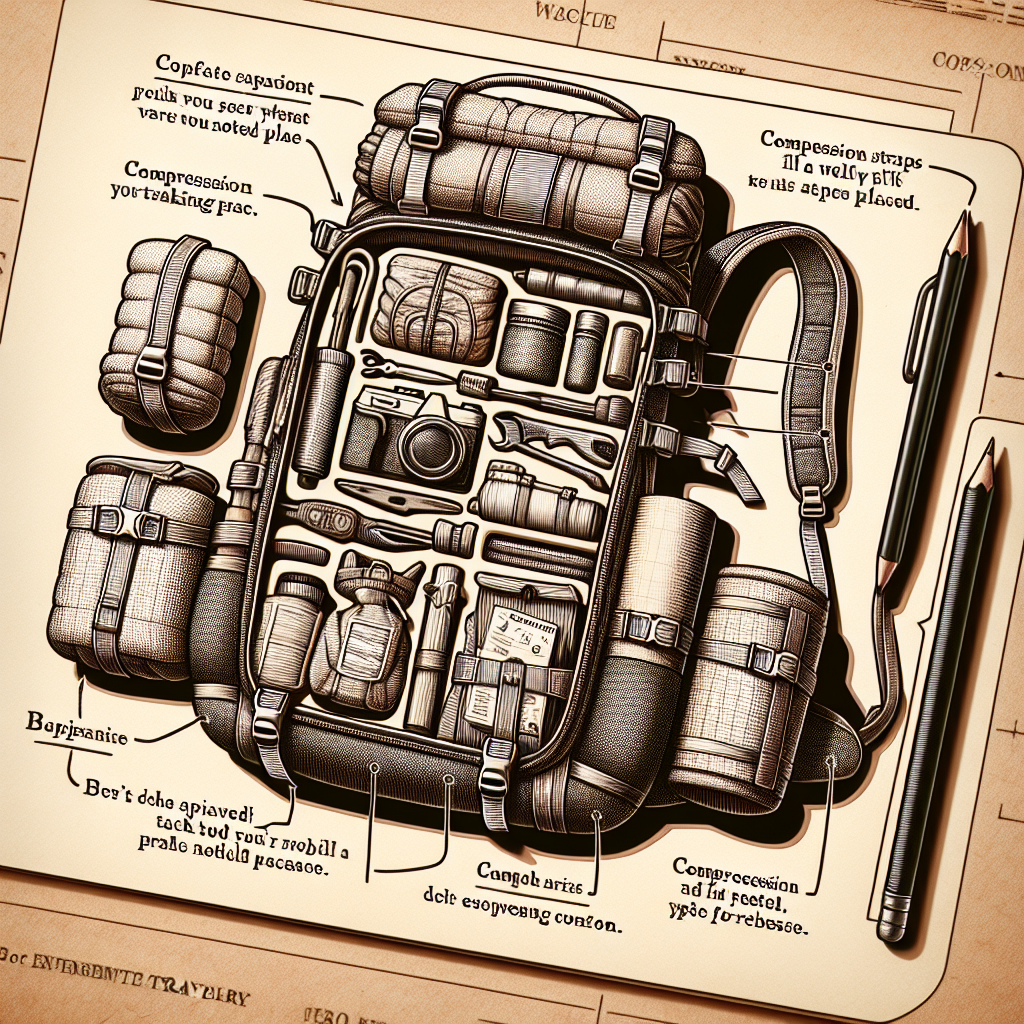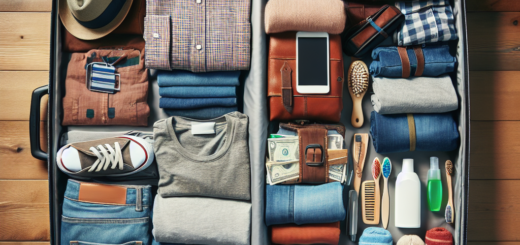How To Pack For A 4-5 Days Backpacking Trip

Heading out on a 4-5 days backpacking trip? Well, you’re in for an adventure! But before you embark on your journey through nature’s wonderland, it’s important to know how to pack efficiently. In this article, we will guide you through the essentials, offering helpful tips and tricks to ensure you have everything you need without weighing yourself down. So grab your backpack, get ready to explore, and let’s dive into the art of packing for a multi-day hike!
Choosing the Right Backpack
Consider the duration of the trip
When choosing a backpack for your 4-5 day backpacking trip, it is essential to consider the duration of your adventure. If you are planning a longer trip or carrying bulky items, a larger backpack with a higher capacity will be necessary. However, for a shorter trip, a smaller backpack will suffice. It’s important to find the right balance between capacity and comfort to ensure that you can comfortably carry all your necessary gear without being weighed down.
Check the capacity and size
Another crucial factor to consider when selecting a backpack is its capacity and size. Backpacks come in various sizes, measured in liters, indicating the volume they can hold. For a 4-5 day trip, a backpack with a capacity of around 40-60 liters is generally sufficient. This size allows you to pack all your essential gear without being bulky or overbearing. Additionally, it’s crucial to try on different backpacks and find one that fits your body comfortably. Adjustable straps and a padded back panel can enhance comfort and distribute the weight evenly.
Look for features and comfort
When choosing a backpack, it’s important to consider additional features that can enhance your comfort and convenience during your backpacking trip. Look for backpacks with multiple compartments and pockets to help organize your gear effectively. Compression straps are also useful for adjusting the backpack’s shape and volume, making it easier to carry. Additionally, padded shoulder straps and a waist belt can provide extra support and distribute the weight more evenly across your body. Remember, comfort is key when you’ll be carrying your backpack for an extended period.
Essential Clothing
Layering system
When packing clothing for your 4-5 day backpacking trip, it’s crucial to utilize a layering system. Layering allows you to add or remove clothing depending on the weather conditions, keeping you comfortable throughout your adventure. Start with a base layer made of moisture-wicking materials to keep you dry. Next, include an insulating layer to provide warmth, such as a fleece jacket or a down vest. Finally, add a waterproof and windproof outer layer to protect you from the elements. This layering system ensures that you’re prepared for all types of weather conditions.
Pack versatile clothing
To maximize the limited space in your backpack, opt for versatile clothing items that can be mixed and matched for different outfits. Select clothing pieces that can be dressed up or down depending on the occasion. For example, a lightweight, quick-drying pair of pants can be worn during the day while hiking and paired with a nicer top for a casual evening out. Choose clothing made from lightweight and breathable materials that can be easily layered or folded to save space.
Consider the weather forecast
Before packing your clothing, always check the weather forecast for your backpacking trip. This will help you determine the types of clothing you’ll need to pack. If the forecast predicts rain, be sure to bring a waterproof jacket and pants. In cold weather, pack additional warm layers such as thermal leggings and a beanie. However, if the forecast indicates hot and sunny conditions, prioritize lightweight and breathable clothing to help you stay cool and protected from the sun.
Toiletries and Personal Care
Pack travel-sized toiletries
To keep your backpack lightweight and organized, opt for travel-sized toiletries. Look for miniature versions of your essential toiletries such as toothpaste, shampoo, and soap. These compact sizes take up less space and weight in your backpack, allowing you to carry other necessary items. Additionally, consider using solid toiletries such as shampoo bars and solid toothpaste to eliminate the need for bulky and leak-prone containers.
Bring a quick-drying towel
A quick-drying towel is a must-have item for any backpacking trip. These towels are lightweight, compact, and dry quickly, making them perfect for outdoor adventures. They can be used for drying off after a swim, as a picnic blanket, or even as a makeshift towel in case of emergencies. Look for towels made of microfiber or other fast-drying materials to ensure efficiency and convenience while on the go.
Consider personal hygiene items
In addition to toiletries, remember to pack any personal hygiene items that you may need during your backpacking trip. This may include items such as hand sanitizer, menstrual products, and any prescription medications. It’s important to anticipate your personal needs and ensure that you have an adequate supply for the duration of your trip. Consider packing these items in a small, waterproof bag to keep them organized and easily accessible.
Food and Cooking Supplies
Plan your meals
When backpacking, planning your meals in advance can help ensure that you have enough food without carrying excess weight. Consider the number of days you’ll be on your trip and plan your meals accordingly. Look for lightweight, non-perishable food options such as dehydrated meals, energy bars, and trail mix. Consider dividing your meals into individual portions and packing them in resealable bags to save space and make mealtime more convenient.
Pack lightweight and non-perishable food
Choosing the right food for your backpacking trip is essential. Opt for lightweight, non-perishable options that won’t spoil during your adventure. Dehydrated meals, instant noodles, and freeze-dried fruits are all great choices. These items are lightweight, easy to prepare, and can be rehydrated with boiling water. Additionally, pack energy-dense snacks like nuts and granola bars to keep you fueled throughout the day without adding unnecessary weight to your backpack.
Bring cooking equipment
If you plan on cooking your meals during your backpacking trip, don’t forget to bring the necessary cooking equipment. A lightweight backpacking stove, fuel canister, and cooking pot are essential items for preparing hot meals. Additionally, pack a lightweight utensil set, including a spork, knife, and collapsible cup. These items will allow you to cook and enjoy your meals comfortably while minimizing weight and space in your backpack.
Sleeping Gear
Choose a suitable sleeping bag
A comfortable and suitable sleeping bag is essential for a good night’s sleep during your backpacking trip. Consider the temperature rating of the sleeping bag and choose one that is appropriate for the climate you’ll be in. If you’re unsure, it’s generally better to choose a sleeping bag with a lower temperature rating to ensure warmth. Additionally, look for a lightweight and compact sleeping bag to minimize the space it takes up in your backpack.
Consider a sleeping pad or mattress
To enhance your sleeping comfort, consider investing in a sleeping pad or mattress. These items provide insulation and cushioning between your sleeping bag and the ground, making for a more comfortable night’s sleep. Choose a lightweight and compact inflatable sleeping pad or a foam camping mattress that fits your needs. Additionally, some sleeping pads come with insulation properties to keep you warm, which is especially beneficial in colder temperatures.
Pack a lightweight and compact tent
If your backpacking trip involves camping overnight, a lightweight and compact tent is a must-have. Look for a tent specifically designed for backpacking, as they are typically lighter and more compact compared to standard camping tents. Consider the number of people sharing the tent and select a size accordingly. It’s advisable to practice setting up your tent before your trip to ensure you’re comfortable with the process and can efficiently set it up on-site.
Navigation and Safety Equipment
Carry a map and compass
When venturing into the wilderness, navigating your way is crucial. Always carry a detailed map of the area you’ll be exploring and a compass to help you stay on track. Familiarize yourself with the map and highlight important landmarks or points of interest. By having a map and compass, you can confidently navigate and avoid getting lost during your backpacking trip.
Bring a GPS device or smartphone with navigation apps
In addition to traditional navigation tools, it can be beneficial to bring a GPS device or smartphone with navigation apps. These devices and apps provide real-time location information and can help you track your progress during your backpacking trip. However, it’s important to remember that these devices rely on battery power and may not always have a reliable signal. Therefore, always have a backup plan and ensure you have a map and compass as well.
Include a first aid kit
Safety should be a top priority during any outdoor adventure. Always pack a first aid kit with essential supplies to handle minor injuries or emergencies that may occur. Your first aid kit should include items such as band-aids, antiseptic wipes, adhesive tape, pain relievers, and any personal medication you may require. Familiarize yourself with the contents of your first aid kit and know how to use them appropriately.
Water and Hydration
Carry a water bladder or water bottles
Staying hydrated is crucial during your backpacking trip, especially when engaging in physical activities. Consider carrying a water bladder or water bottles to ensure you have access to clean drinking water throughout your adventure. Water bladders are lightweight and can be conveniently placed in your backpack, allowing you to sip water through a tube. Alternatively, reusable water bottles are more durable and can be attached to the outside of your backpack for easy access.
Pack a water filter or purifier
When venturing into the wilderness, it’s important to have a reliable method of purifying water to ensure it is safe to drink. Consider packing a water filter or purifier to remove harmful bacteria, parasites, and viruses from natural water sources. There are various options available, including pump filters, gravity filters, and UV purifiers. Choose the option that best suits your needs and the conditions you’ll be facing during your backpacking trip.
Consider electrolyte supplements
In addition to clean drinking water, it’s important to replenish electrolytes lost through sweat during physical activities. Consider packing electrolyte supplements such as tablets or powder packets to add to your water. These supplements can help prevent dehydration and ensure your body maintains its electrolyte balance, especially in hot and humid conditions. Remember to read and follow the instructions on the packaging for proper dosage and use.
Lighting and Electronics
Pack a headlamp or flashlight
Proper lighting is essential for navigating and performing tasks in low-light conditions during your backpacking trip. Pack a reliable headlamp or flashlight to ensure you have a hands-free light source. Headlamps are particularly useful as they allow you to have both hands free while still providing adequate illumination. Additionally, choose a headlamp or flashlight with adjustable brightness settings to conserve battery life and adjust to your specific lighting needs.
Bring extra batteries or a portable charger
To avoid being left in the dark, always bring extra batteries or a portable charger for your lighting and electronic devices. Depending on the duration of your backpacking trip, it’s essential to have a reliable power source to ensure your devices remain functional. Consider investing in rechargeable batteries or a portable charger powered by solar energy to keep your essential devices powered up while minimizing waste.
Consider solar-powered devices
To reduce your carbon footprint and minimize reliance on disposable batteries, consider using solar-powered devices during your backpacking trip. Solar-powered lanterns, chargers, and even watches are readily available and can harness the power of the sun to charge your devices. While they may not be as efficient as traditional battery-powered devices, they offer a sustainable option for powering essential items while outdoors.
Emergency Supplies
Include a whistle and a signal mirror
Emergency supplies are crucial for any backpacking trip to ensure your safety in unforeseen situations. Include a whistle in your backpack as an effective way to signal for help in case of an emergency. Additionally, pack a signal mirror, which can be used to attract attention from rescue teams or other hikers by reflecting sunlight. These compact and lightweight items can make a significant difference in potentially life-threatening situations.
Pack a lightweight emergency shelter
In the event of unexpected weather changes or an emergency situation, a lightweight emergency shelter can provide protection and safety. Consider packing a compact, lightweight emergency bivy or a tarp that can be easily set up to shelter you from rain, wind, or extreme temperatures. These shelters are designed to be compact and lightweight, ensuring they don’t add unnecessary bulk to your backpack while providing a reliable source of protection.
Bring a multi-tool
A multi-tool is a versatile item that can prove invaluable during your backpacking trip. These compact tools often incorporate pliers, knives, screwdrivers, and other useful features into a single device. Having a multi-tool on hand allows you to perform various tasks such as repairing gear, opening cans, or cutting rope. Look for a lightweight and durable option that fits your needs and ensure it is easily accessible in your backpack.
Miscellaneous Items
Pack a lightweight backpacking stove
If you plan on cooking hot meals during your backpacking trip, a lightweight backpacking stove is essential. These compact stoves are designed to be lightweight and efficient, using minimal fuel while providing a reliable heat source. Consider a stove that uses canister fuel as it is typically easier to control and more convenient. Always follow the manufacturer’s instructions and exercise caution when using any camping stove.
Bring a repair kit for equipment
During your backpacking trip, equipment damage or malfunctions can occur. Packing a repair kit that includes duct tape, a sewing kit, and extra cords can help you fix minor issues on the go. For equipment-specific repairs, consider including spare parts such as tent pole sections, zipper pulls, or stove O-rings. A well-prepared repair kit can save you from potential setbacks and ensure your gear remains functional throughout your journey.
Consider entertainment and personal items
While backpacking is primarily about connecting with nature and enjoying the outdoors, it’s also essential to consider personal enjoyment. Consider packing entertainment items such as a book, a deck of cards, or a lightweight musical instrument to unwind during downtime. Additionally, bring personal items that provide comfort and enhance your overall experience, such as a comfortable camp chair, a travel pillow, or a journal to document your adventures. These items can add a personal touch to your backpacking trip and contribute to a more enjoyable experience.
By considering the duration of your trip, choosing the right backpack, and packing essential clothing, toiletries, food, and sleeping gear, you’ll be well-prepared for your 4-5 day backpacking adventure. Remember to include navigation and safety equipment, prioritize hydration and lighting, and pack emergency supplies for unforeseen situations. Don’t forget to bring a repair kit, consider personal entertainment items, and most importantly, have a wonderful time exploring the great outdoors!



